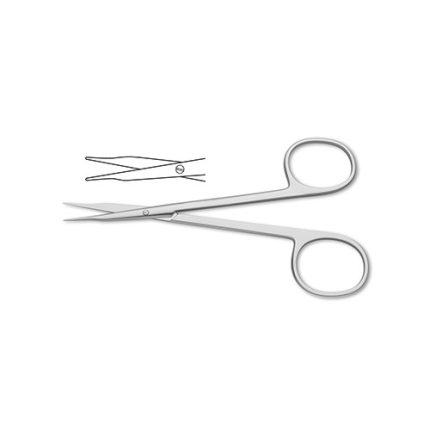Shepard-Westcott Tenotomy Scissors
blunt tips, serrated upper blade, 20.0 mm from screw to tip, curved, 4-7/8" (12.4 cm) Shepard-Westcott Tenotomy Scissors are a commonly used tool in ophthalmologic surgeries. The scissors are designed to cut the insertion of the extra-ocular orbital muscles. This is accomplished by placing one blade of the scissors behind the tendon. The scissors feature blunt tips to reduce damage to the surrounding orbital tissue. Additionally, the serrated blades help grasp tissue to minimize slippage.
Simcoe Cortex Extractor
23-gauge Simcoe Cortex Extractor is a useful tool in cataract procedures. Following emulsification, if part of the lens cortex remains, the extractor is used to remove the tissue especially at the difficult 12'oclock position. Two different working lengths are available depending on surgical preference.
Simcoe Lens Loop
double ended, 4.0 mm x 20.0 mm serrated loops, 5-1/2" (14.0 cm) Simcoe Lens Loop is a useful tool in a variety of cataract and lens extraction procedures. The loop features a wider set cup to scoop the lens for extraction. The serrated wire aids in gripping the lens to prevent the lens from slipping into the vitreous. The double-ended design allows the surgeon to adjust during the procedure as needed.
Simcoe Reverse Double-Barreled Irrigating/Aspirating Unit
irrigation through main w/ aspiration through side taper, 23.0 mm port Simcoe Reverse Double-Barreled Irrigating/Aspirating Unit is a prescribed tool for used in phacoemulsification procedures. The aspirator may be used to clean out the capsular contents for epinuclear debris following removal of the nucleus. The side-tapered design allows for quick and efficient cleaning of the capsular bag.
Sinskey Tying Forceps
micro tip with 7.0 mm tying platform, straight, 4-1/4" (11.0 cm) Sinskey Tying Forceps are a commonly used ophthalmologic instrument, particularly in cataract operations. The forceps are ideal for handling 8-0 to 11-0 sutures. The micro tip is designed to give the surgeon maximum control during the procedure, while the platform allows the simultaneous handling of tissue and suturing material.
Skeele Curette
serrated edge, 2.0 mm, 5" (12.5 cm)Skeele Curette is a popular tool used to remove cysts or masses of the lid. The curette features a sharp rounded blade helping to excise the lid mass and are best used with a chalazion clamp. In addition, the curette features a serrated edge to aid in grasping excised tissue.
Snellen Entropium Forceps
35.0 mm wide solid plate, 3-1/2" (8.9 cm) Snellen Entropium Forceps are a commonly used tool to hold the eyelid in place during corrective surgery. The solid plate is placed on the inside of the lid to expose the folded over tissue and is sandwiched between the upper blade. Both right and left eye forceps are available in this model.
Stern-Castroviejo Suture Forceps
wide handle, 0.5 mm teeth & lock, w/ platform, straight, 4-1/8" (10.5 cm)Stern-Castroviejo Suturing Forceps are a multipurpose tool for a variety of ophthalmologic procedures. The heavy set teeth ensure the firm grasp of tissue or suturing equipment without slippage. The forceps are available with a tying platform, designed to grasp both the tissue and suturing equipment without changing instruments. A locking mechanism is built into the forceps, which frees the surgeon's hands during the procedure.
Stern-Gills Scissors
thin blades w/ sharp tips, 10.0 mm length, angled forward, 4-3/4" (12.0 cm)Stern-Gills Scissors are a widely used tool, particularly in capsulotomies. The long thin blades of the scissors are designed to radially incise the capsule. The angled forward design allows more accurate contouring to the capsule, while finger holes in the handle allow for a more ergonomic grip.
Stevens Tenotomy Scissors – Mirror Finish
mirror finish, blunt tips, 4-1/2" (11.5 cm) Stevens Tenotomy Scissors are a commonly used tool in ophthalmologic surgeries. The scissors are designed to cut the insertion of the extra-ocular orbital muscles. This is accomplished by placing one blade of the scissors behind the tendon. The scissors feature blunt tips to reduce damage to the surrounding orbital tissue and are available in a straight or curved profile depending on surgical preference.
Stevenson Lacrimal Sac Retractor – Curved Teeth
curved teeth, 20.0 mm spread, 3-1/3" (8.5 cm) Stevenson Lacrimal Sac Retractor is a specialized tool during dacryocystectomy procedures. The instrument is designed to widen the edges of the skin incision, exposing the lacrimal sac. The retractor features blunt prongs designed to minimize disuse damage. Up to a 20.0 mm spread can be achieved to accommodate patient variation.
Stevenson Lacrimal Sac Retractor – Solid Serrated Blades
solid, serrated blades, 20.0 mm spread, 3-1/3" (8.5 cm) Stevenson Lacrimal Sac Retractor is a specialized tool during dacryocystectomy procedures. The instrument is designed to widen the edges of the skin incision, exposing the lacrimal sac. The retractor features serrated tips designed to minimize tissue slippage. Up to a 20.0 mm spread can be achieved to accommodate patient variation.












